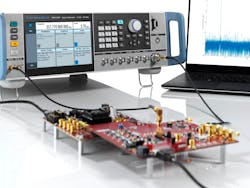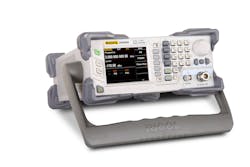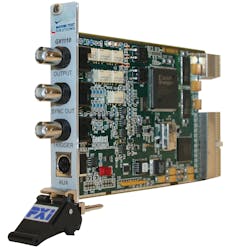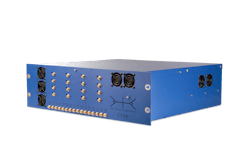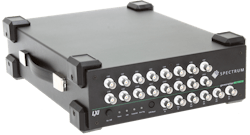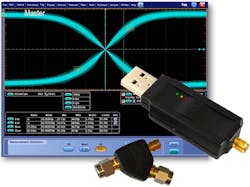Download this article in .PDF format.
Signal generators are a crucial element in many areas of product design, development, production, and field testing. While their longstanding applications include base stations, radar, and EMC, new-age demands like 5G and the Internet of Things continue to make modern signal generators highly valuable pieces of test equipment.
To take a deep dive into this test-instrumentation topic, EE gathered commentary from various makers of signal generators to get their thoughts on technology trends and challenges, customer demands, and what newer solutions are on the market. Read on to see what they told us.
What’s trending?
What technology or market trends are vendors seeing in the area of signal generators?
Brandon Malatest, founder and CEO of Per Vices Corp.: “There has been a significant shift in the flexibility and performance demanded by customers in the RF/microwave signal-generator market. The industry now requires signal generators that can operate over very wide frequencies, support very high bandwidths, and have the flexibility that was traditionally only available through multiple pieces of equipment—each serving a different need. This has led to an increase in the need for software defined radios (SDR) to be used in replacement of legacy RF/microwave signal generators.”
Steve Sandler, founder and CEO of Picotest: “More features and lower prices. Companies like ours are introducing very small, high-speed edge generators for scope-based time-domain reflectometry (TDR) and scope-based vector-network-analyzer (VNA) applications, which have been seeing increased domain.”
Oliver Rovini, technical director of Spectrum Instrumentation GmbH: “We see a trend towards more simultaneous output channels in a single device. While classic signal generators have one or two outputs in a single bench-top device, there are now more and more signal generators and arbitrary waveform generators (AWG) coming to market that have four or even eight channels. Modular concepts like those offered by Spectrum even allow 16 or more AWG channels in a single device. Even benchtop devices nowadays come without any manual operating interface but are solely operated through Ethernet/LXI by the PC.”
Simon Ache, director of signal generation product management at Rohde & Schwarz: “The use of RF technology is getting more and more diverse. Applications range from cellular communications (5G, IoT), home automation, Industry 4.0, location-based services, and short-range mobile applications to automotive radar and satellite-based communication systems. This propels a general hunger for RF spectrum. However, wide contiguous spectrum—as, for example, needed for higher data throughput and bigger capacity—is generally only available at higher mmWave frequencies.”
Jon Semancik, director of marketing at Marvin Test Solutions: “There is a continuing trend to reduce overall system footprint. Therefore, customers are looking for a full-featured instrument in a smaller package, such as PXI/PXIe. This trend is apparent in the drive to support 5G and other emerging technologies as more and more functionality is implemented in this compact package.”
Keysight Technologies’ signal-generator product managers Kimberly Cassacia, Sean Lee, and Xiaowei Zhang and signal-generator product marketing manager Eric Hsu: “First, implementation of direct digital synthesis (DDS). With technologies evolving, a high-frequency precision reference clock enables DDS toward higher frequencies. A DDS’s synchronous reset to the phase accumulator can achieve phase alignment. Second, integration of vector transceivers. Demands for multiband and multiformat high-volume wireless production tests have been increasing. Vector transceivers are purpose-built for rapid solution creation and faster throughput in manufacturing test of wireless devices and components. Third, multichannel test systems. Testing multi-antenna systems such as spatial diversity, spatial multiplexing, and antenna array requires a test system capable of providing multiple signals with stable phase relationships between them.”
James McGregor, global head of test, tools, and production supplies at Newark: “Within the high-performance signal-generator area, it is all about 5G as demand increases for complete testing solutions for 5G products. At the lower performance end of the market, manufacturers are combining multiple test solutions into a single piece of equipment. An example is the integration of signal generators into oscilloscopes providing increased value for money, and in many cases a smaller footprint on your bench. In general, both wireless connectivity and touchscreen functionality are required features in all equipment.”
Chris Armstrong, director of product marketing and SW applications, RIGOL Technologies: “As complex RF modulation continues to expand use in more electronic products, the need for advanced signal-emulation capabilities continues to grow. This is especially true of devices operating in standard ISM bands where interference and spectrum sharing are becoming more important test points. Traditional RF signal generators designed for these relatively low-frequency carriers were either too expensive or not capable enough to emulate complex signals. One of the key development trends is the requirement for complex and custom IQ signal emulation in cost-effective RF signal generators.”
Steve Fairbanks, senior director, marketing, products, and instrumentation at Astronics Test Systems: “Today’s signal generators are reducing in overall size, adding more channels per instrument package, and providing more flexibility in programming. All of these trends have made it possible to provide high-performance signal generators in small form factors such as USB and PXI. These technologies can then easily be integrated in low-power-usage platforms for portable products such as handheld instrument or tablet-based instruments.”
Mark Elo, U.S. sales manager for Tabor Electronics: “Many applications today for analog signal generators are supporting emerging mmWave technologies that are deployed in the unlicensed band and automotive radar bands. Most of the measurements can be performed using standard equipment such as oscilloscopes. A cost-efficient way of doing this is to use downconverters with analog signal generators as the LO.”
Margaret Grattan, signal sources product manager at Tektronix: “We’re seeing AWG customers wanting to create more complex signals for sophisticated test scenarios. In this instance, engineers and researchers need the ability to accurately recreate real-world signals and cycle through signal tests quickly. Applications where this is becoming increasingly important include radar, quantum computing, advanced communication systems, hardware-in-the-loop (HIL) test simulation, and electronic warfare.”
Challenges
What key challenges are signal generator vendors or their partners facing today?
Malatest, Per Vices: “There are challenges associated with any new innovation, and I believe the demand for both higher bandwidth and wider operating frequency are the biggest contributors to signal-generator manufacturers today. Due to limitations in some performance aspects of integrated circuit silicon, manufacturers of SDRs (and traditional signal generators) are required to develop more sophisticated radio chains, incorporate higher speed digital design, and offer support to accommodate the high bandwidth both in the digital and analog domains.”
Sandler, Picotest: “GaN is at a pivotal point in history. As the market shifts from silicon to GaN, new design, simulation, and testing skills are needed. Semiconductor manufacturers aren’t really keeping up with market needs on the ultra-fast driver devices.”
Rovini, Spectrum Instrumentation: “Size always matters. With more channels per unit, more power is needed and more heat needs to be disposed. This is in opposition to the customers’ demand for smaller instruments. Wide software support becomes more and more important for many customers as there are plenty of different software packages on the market and customers like to use the one that they know best and that can fit best their need. Manufacturers need to offer support and examples for a wide range of packages and need to listen carefully to customer demands.”
Semancik, Marvin Test Solutions: “One of the key challenges that many manufacturers face is not necessarily unique to the signal-generator market and involves designing products for long life-cycle requirements. Many MIL/aero applications require product support cycles of 10 to 15 years and beyond, which can be challenging as components reach end of life—often prompting expensive last-time buys or form-fit-function redesign. Customers should therefore be careful to select manufacturers with a proven long-term support record to ensure the longevity of their test systems.”
Ache, Rohde & Schwarz: “As the lower part of the RF spectrum is getting more congested, also traditional applications move to higher frequency bands. 5G FR2 applications currently aim for frequencies up to 44 GHz, and 6G will presumably use even higher frequencies. Automotive radar jumped from 24 GHz to the 79 GHz band and satellite applications tend to move into the Q/V bands. This has a couple of consequences. Signal purity is getting more important since effects like SSB phase noise that are small at frequencies below 6 GHz can become dominant at mmWave. The flatness of modulated wideband signals is getting important, too.
Keysight: “First, wider bandwidths and new frequency bands. Cellular communications are moving from 4G toward 5G to achieve extreme data throughputs; satellite communications are building huge networks in space allowing high-speed communications from anywhere. Second, complex modulation schemes. In modern wireless communications, modulation schemes are becoming more complicated in order to improve spectral efficiency. Complex modulated signals result in a higher peak-to-average power ratio, which lead to more nonlinear distortions for signal generation. Third, complex multi-antenna configurations. Most of the new wireless technologies are adopting multi-antenna techniques such as multi-input multi-output and beamforming to improve spectral efficiency and radio coverage.”
McGregor, Newark: “The ability to meet the needs for 5G testing is the main challenge for high-performance equipment—as equipment investments made by customers now will need to support the testing of products that have not yet even made it to the drawing board. At the lower performance end of the market manufacturers continue to squeeze more and more functions and features into a single piece of equipment meeting the challenge of smaller, lighter, and more and more portable equipment, yet with large touch screens for ease of use.”
Armstrong, RIGOL Technologies: “More RF designs are being taken to market by startups and small engineering firms without access to all the RF test equipment they used to have just down the hall. These engineers are testing modern RF designs that require more complex signal types as well as higher power signals for many of their new test applications. The integration and development of these capabilities in solutions that are still affordable make it easier for engineers to bring their ideas to market on time and in budget.”
Elo, Tabor Electronics: “New commercially available chips are allowing for smaller form-factor, lower cost signal-generation technology. Less than five years ago, for example, a mid-performance signal generator would be a single-channel, 3U rack model; however, today, in the same rack space you can fit up to four signal generators, and with portable generators, 16 or more can fit in a 3U rack configuration.”
What are customers asking for? What key features or attributes are customers asking for in signal generators?
Malatest, Per Vices: “Customers evaluating different signal generators are looking for more than just the traditional features (frequency stability, sweep speeds, etc.) offered by legacy equipment. More and more are looking for added flexibility through the inclusion of FPGAs, a greater number of channels, wide operating frequency, and high bandwidth. These features become increasingly important as applications become more advanced. There is also an increasing need for low phase noise and aggressive channel masking requirements to be met. Although this feature is not always required, it is becoming increasingly popular for high performance applications.”
Sandler, Picotest: “I can only speak to what our customers are asking for—they want easy-to-use tools that allow them to solve problems, and as inexpensively as possible. Maybe it is our niche, but we have a lot of customers asking for signal generators for TDR and harmonic comb applications that work with their oscilloscope. We now offer such a tool in a USB stick configuration, but the oscilloscope manufacturers need to include GUI support and calibration within the scope to make the best use of our tools.”
Rovini, Spectrum Instrumentation: “As setups are getting more complex, there's a large demand for mixed-mode applications, having a signal generator with a number of freely programmable marker outputs. While classic benchtop devices normally only have a single trigger/sync output, Spectrum products offer up to 20 additional digital marker outputs with the AWG instruments to control a large number of external devices. A second demand is for high output levels in conjunction with high bandwidths. Spectrum AWGs of the M2p.65xx Series allow an output level of ±6 V for each channel on a single PCIe card with eight AWG channels.”
Ache, Rohde & Schwarz: “To enable our customers to not only pursue, but to push the technological barriers of their products, we have to offer modern signal generators that cover mmWave frequencies of up to 70 GHz, offering excellent signal purity and high output power. Vector signal generators additionally need to support bandwidths of typically up to 2 GHz while meeting the requirements for spectral purity, flatness, and modulation quality. Since applications are diverse, T&M instruments need to offer the flexibility and scalability that allows tailoring to the specific test need. Furthermore, we see an increasing demand for propagation channel simulation at mmWave frequencies.”
Semancik, Marvin Test Solutions: “In many ways, the basic requirements have not changed much over the year. Customers expect ease-of-use, output stability and accuracy, as well as comprehensive user interfaces. That being said, customers tend to look for the broadest frequency ranges while still achieving required accuracy specifications.”
McGregor, Newark: “Key features regularly requested are a large touch screen, fast data-processing speed, and an automated test solution. Key attributes include frequency range, output power, phase noise, harmonics, and switching frequency.”
Armstrong, RIGOL Technologies: “Due to design requirements, engineers are always asking for expanded power envelopes and additional signal modulations. The ability to generate custom IQ modulation patterns is especially important to customers in early product and technology development.”
Fairbanks, Astronics Test Systems: “Generally speaking, we are being driven to provide more complex generation capability, on more channels, in the smallest package possible. Customers’ needs for increasingly complex waveform generation have also driven us to provide native software tools to assist in solving these problems. Signal generators nowadays can’t just provide raw signal generation—customers are demanding a full-featured application software set to accompany the hardware.”
Now on the market
What signal generator solutions (including accessories) have come on the market recently, and what are their key features?
Sandler, Picotest: “A few years ago we introduced a fast pulse edge generator—PerfectPulse—in a USB stick. It supported harmonic comb and TDR solutions up to about 1 GHz. Last year we introduced a 32-ps version, also in a USB stick. Customers also need to connect the generators to their circuit boards, which often are not connectorized and frequently don’t have fine-pitch launch pads. We are developing high-bandwidth probes to accommodate the requirements. Even 5 GHz in a 50-Ω probe is tough to achieve with 2.5-mm, 4-mm, or variable pitch required by many applications.”
Malatest, Per Vices: “Our latest release, Cyan, is a SDR that offers all of the key features demanded by the signal-generator market. It offers operation from near DC to 18 GHz with up to 16 independent, phase-coherent, radio chains each having 1-GHz sampling bandwidth. The unit features a Stratix 10 SoC FPGA with the ability to meet very aggressive channel-masking requirements.”
Ache, Rohde & Schwarz: “We have recently expanded the available frequency options for our analog high-end RF and microwave signal generator R&S SMA100B, offering now a contiguous frequency range from 8 kHz to up to 72 GHz. The instrument provides the purest output signals while maintaining the highest output power level, far outpacing the competitive solutions. It is capable of handling the most demanding component, module, and system T&M tasks in the RF semiconductor, wireless communications, and aerospace and defense industries.”
Keysight: “Our VXG M9384B/M9383B microwave signal generator is the first dual-channel microwave signal generator that supports up to 44-GHz signals and and having a 2-GHz RF modulation bandwidth in a single instrument. It features unmatched RF performance that optimizes measurement integrity and minimizes uncertainty for wide bandwidths at millimeter-wave frequencies; a new graphical user interface for 5G NR that delivers a streamlined experience when creating standard-compliant test signals; and user-centric interfaces—multitouch and modular.”
Semancik, Marvin Test Solutions: “MTS manufactures high-performance PXI-based signal generators that offer both function-generator and AWG functionality within one instrument. Built-in waveforms are available for use with both the DDS or AWG modes of operation and include sine, triangle, ramp, noise, Gaussian pulse, and sinx/x. A flexible sequencer is also available as part of the AWG's architecture, supporting the generation of complex waveforms. WaveEasy, a comprehensive software tool used to create, modify, and analyze waveforms is included, along with the virtual soft front panel that can be used to interactively program and control the instrument, and display the instrument’s current settings and status.”
McGregor, Newark: “Recently launched products include the Rohde & Schwarz FPC spectrum analyzer with signal generator functionality built in. The R&S FPC1500 combines a spectrum analyzer, network analyzer, and signal generator in one instrument…suitable for university laboratories, research institutions, as well as production and service facilities. The Rohde & Schwarz® SMC100A RF and microwave signal generator is a flexible and versatile instrument…covering the frequency range from 9 kHz to 1.1 GHz or 3.2 GHz. Output power is > +17 dBm and all important functions (AM/FM/φM/pulse modulation) are already integrated in the instrument. The Tektronix AFG31000 arbitrary function generator is a best-in-class waveform-generation platform with new interactive features for unprecedented user experience, performance and versatility. And the TGF4000 Series from Aim-TTi [builds on] 20 years of experience in the industry to address demand from customers for increasingly high frequency and precision in their test signals. The TGF 4000 series delivers high precision, wide bandwidth models with class-leading performance alongside unrivalled value for money. At the higher end of the series, the new TGF4162 and TGF4242 offer extended frequency and level that may not have been affordable to customers previously. The TGF4000 offers key advantages over other models in this price range such as a true dual channel generator.”
Armstrong, RIGOL Technologies: “RIGOL has just released our latest DSG800A Series signal generators. The DSG800As now include signal generation up to 3.6 GHz with the ‘A’ models including custom IQ signal generation standard. With typical power output up to +20 dBm engineers can now extend their RF test capabilities with new technology at an incredible value.”
Elo, Tabor Electronics: “The Lucid series of RF signal generators is our newest product line, providing mid-performance, analog RF signal generation. Lucid takes a platform approach with a unique, modular architecture and features excellent phase noise (better than 130 dBc at 1 GHz measured at a 10- to 20-kHz offset), wide output power range (-90 dBm to 15 dBm), fast switching(< 100 μs), full analog modulation, and legacy backwards code compatibility.”
(Editor’s note: Astronics Test Systems is the U.S. solutions provider offering sales and support for Tabor Electronics, based in Israel.)
Grattan, Tektronix: “In February of this year, Tektronix enhanced the AWG70000 with the addition of Streaming Waveform ID and an option to increase memory depth up to 32 GSamples to support customers signal-generation needs. The Streaming Waveform ID feature gives users immediate access to a total of 16,383 sequence steps though a direct Ethernet interface. Currently they are limited to 256 sequence steps accessible through an 8-bit-pattern jump connector. With this expanded access, users can change waveforms quickly to replicate the chaos of real-world simulations far more accurately than possible with the jump connector.”
Applications
What applications have customers been using these vendors’ signal generation instruments for?
Malatest, Per Vices: “The applications of our SDR-based signal generators have been very widespread and include several test and measurement applications, radar exciters (and receivers), MRI transmitters (and receivers), as well as for low-latency communications. The flexibility of our systems enables users from across several markets to use the equipment with different software applications enabling their desired configurations.”
Rovini, Spectrum Instrumentation: “One of the application areas with an increased demand is quantum research. Most experiments require a number of analog AWG channels as stimulus in conjunction with multiple individually programmable digital outputs to control the equipment of the experiment with a very fine time resolution. Our DN6.66x series of AWGs with four to 24 AWG channels and 1.25-GS/s output rate has been used in many applications there. It offers six synchronous digital outputs that have the same time resolution of 800 ps.”
Ache, Rohde & Schwarz: “The applications from our newest signal-generator solutions range from LO substitution—testing components such as differential ADCs or dual-input PAs via characterization of satellite and radar modules—to performance characterization of completely integrated wideband receivers and conducting automated OTA tests.”
Armstrong, RIGOL Technologies: “Complex signal emulation is one of the most demanding applications RIGOL serves, but RF signal generators are also commonly used in EMI immunity testing as an interference source. In addition to device characterization and failure analysis of RF and embedded components, engineers also use RIGOL signal-generation products from mHz to GHz for a wide variety of research including biology, chemistry, and physics.
Elo, Tabor Electronics: “Our signal-generator products find use in EMC, chamber-isolation, and intermodulation testing and can serve as mixer LO drivers and clock sources.”
Grattan, Tektronix: “Our signal generators are used in almost every functional role from R&D to production lines. Our instruments are also used extensively in the field in operational roles as part of larger systems. To this point we design and test our instruments extensively to ensure correct operation in the most extreme environmental and atmospheric conditions.”
For more information:

